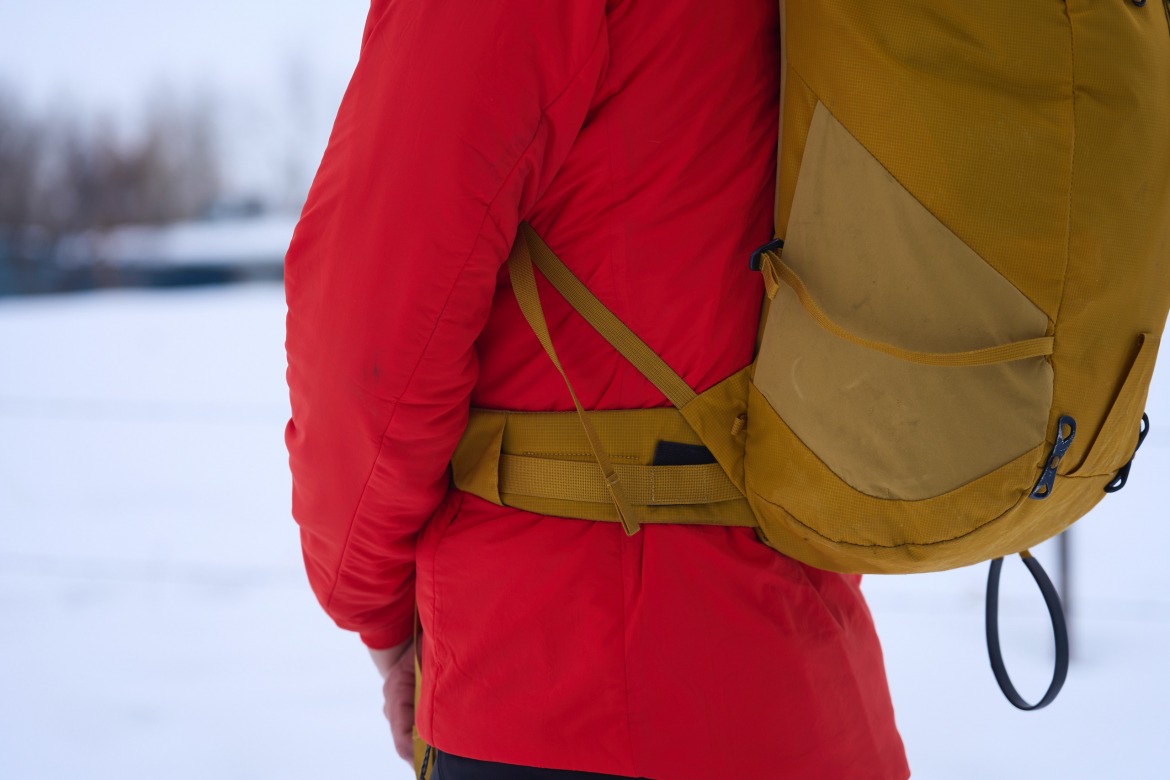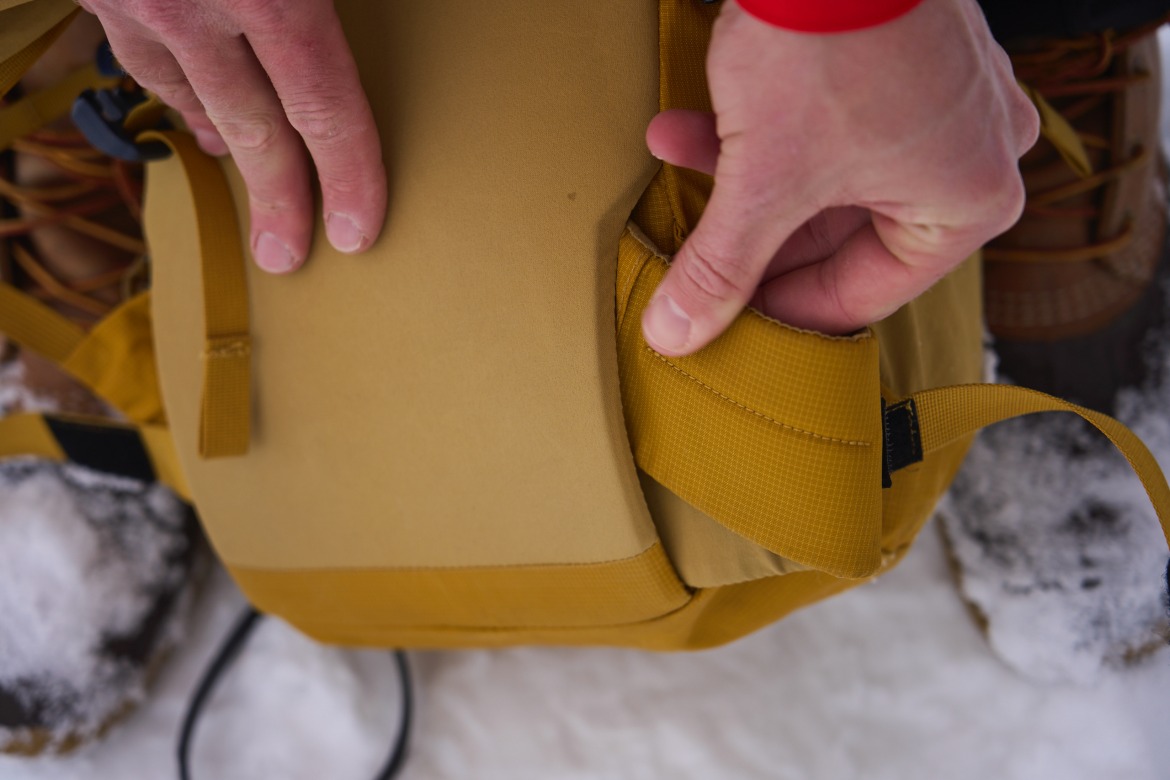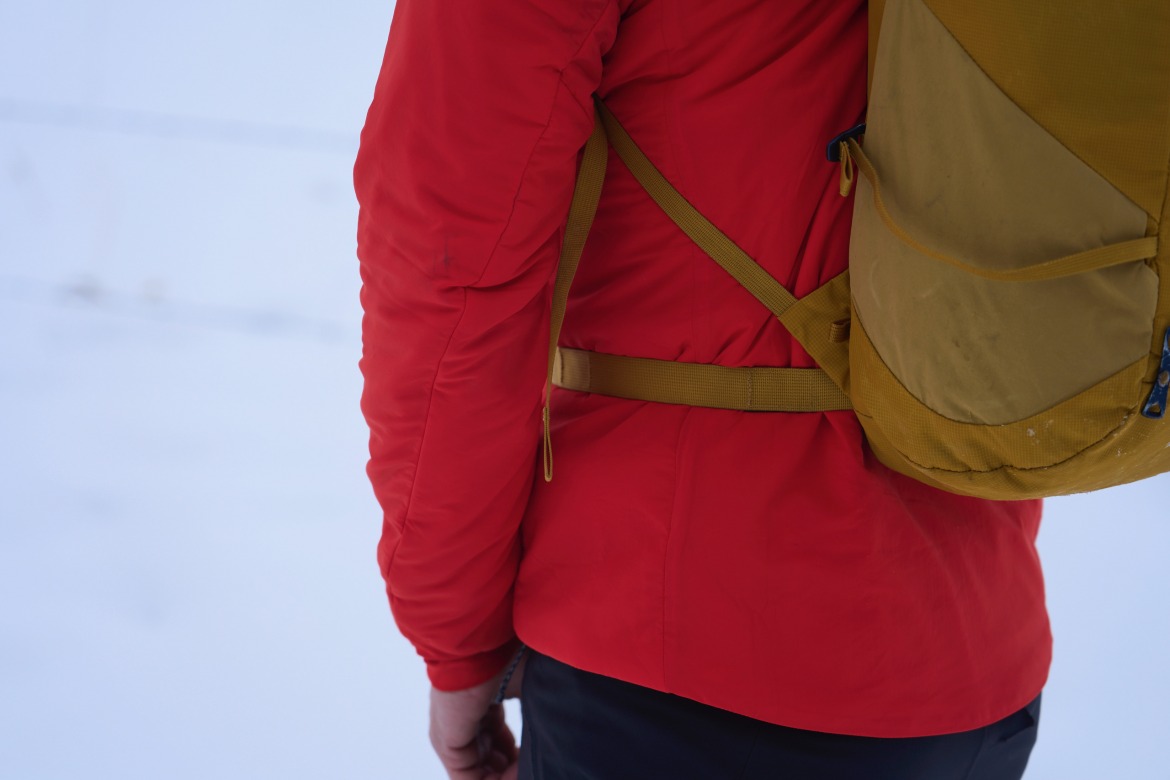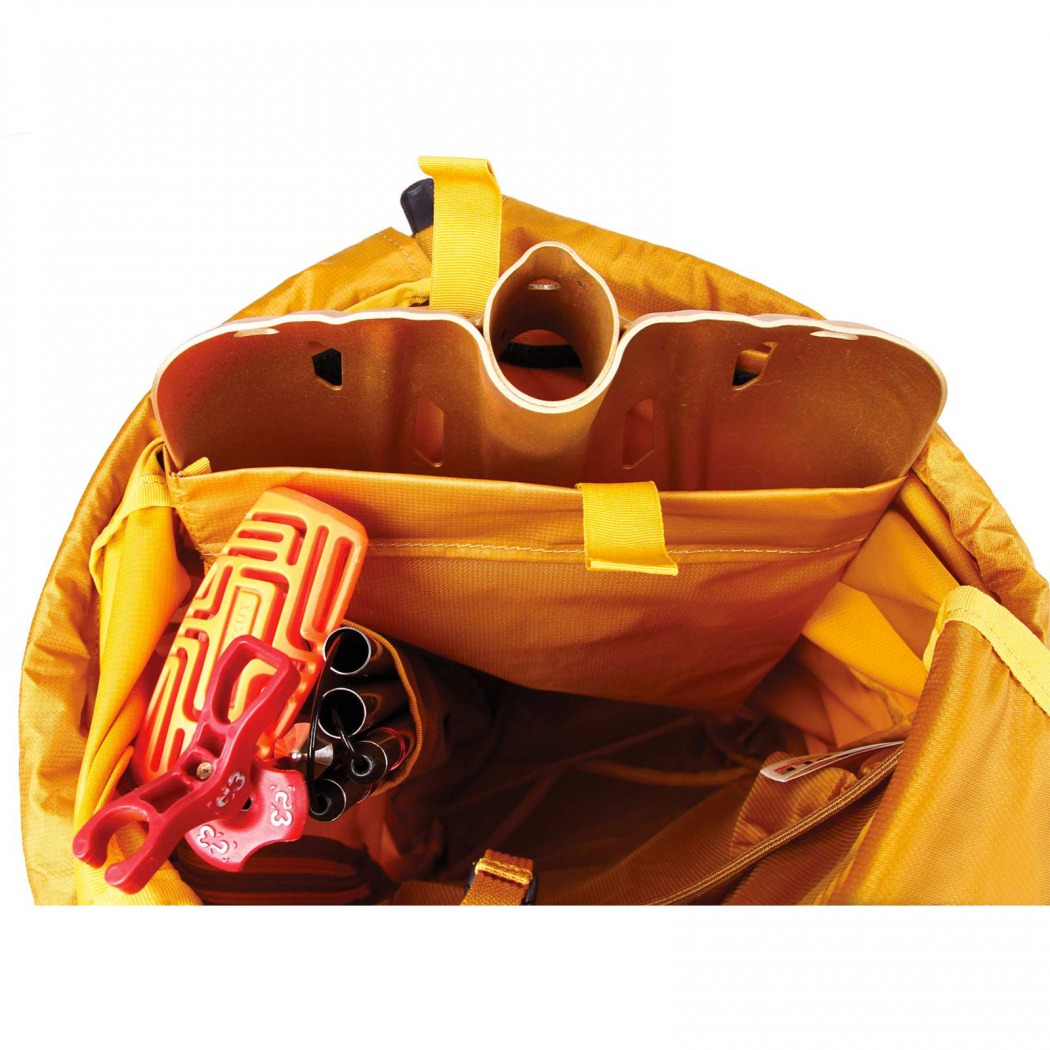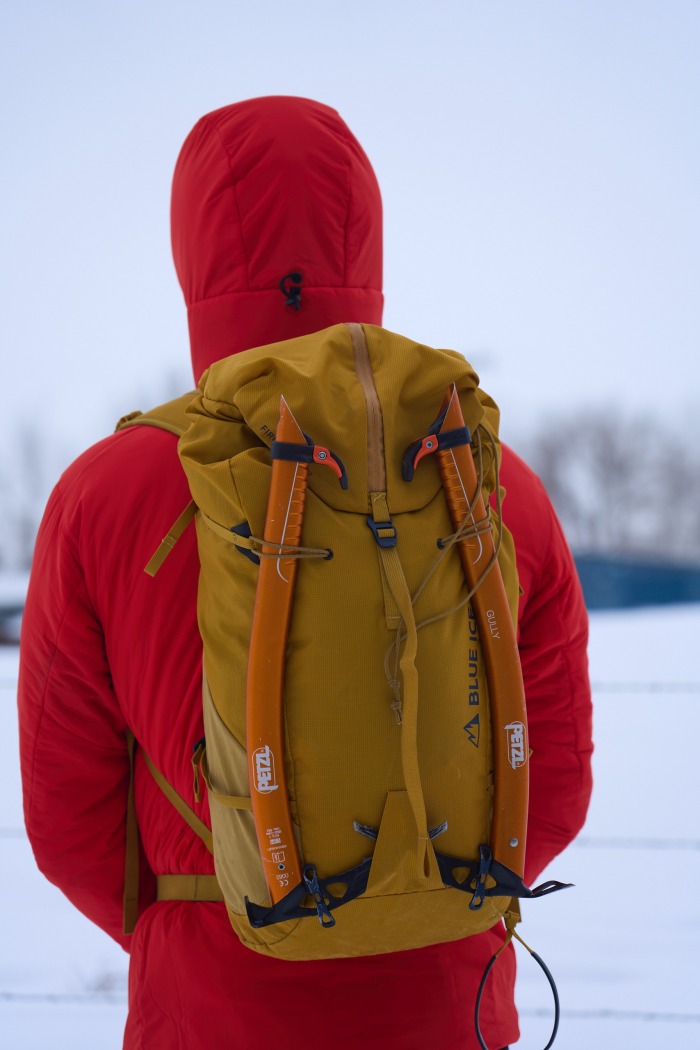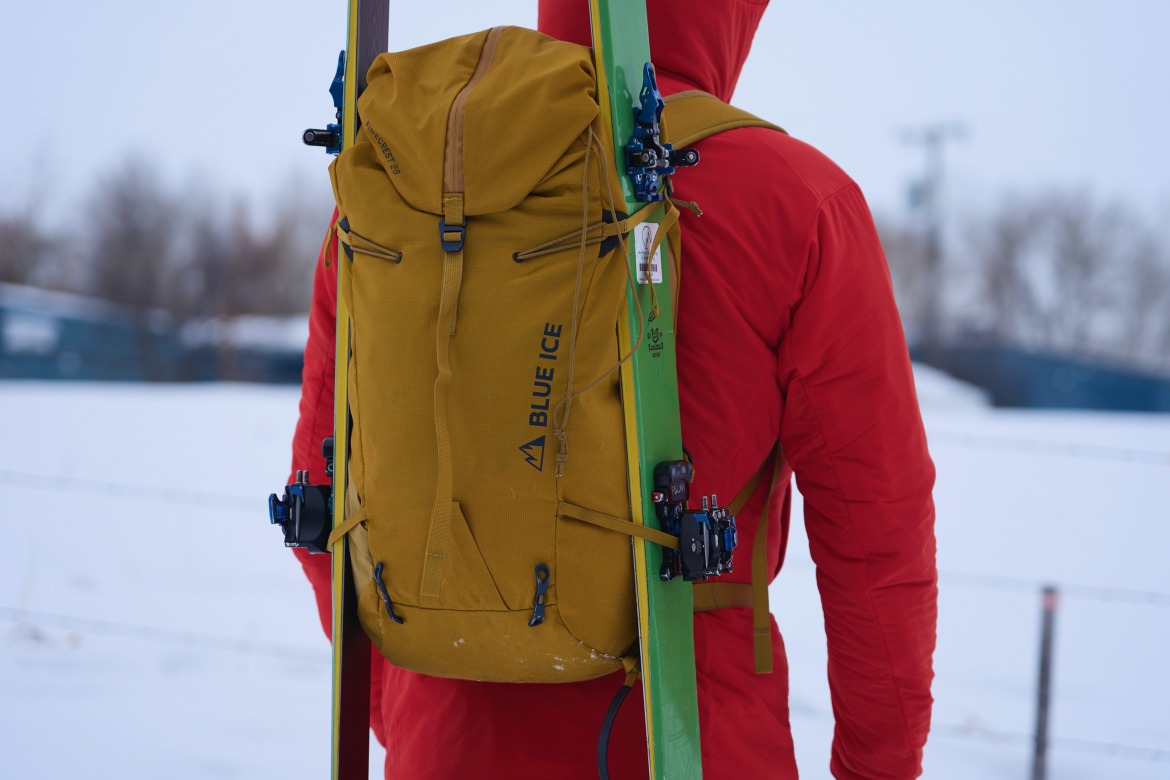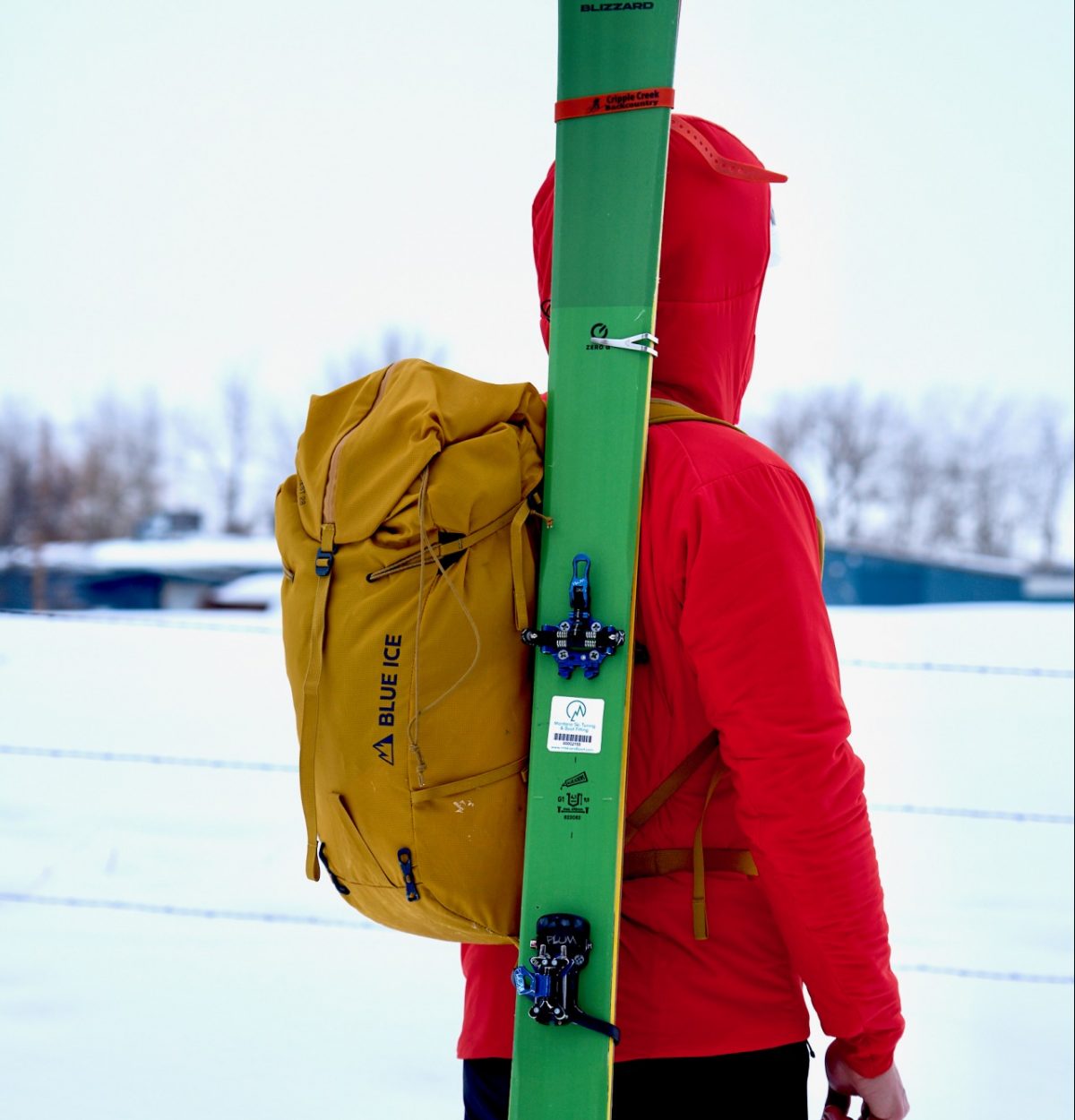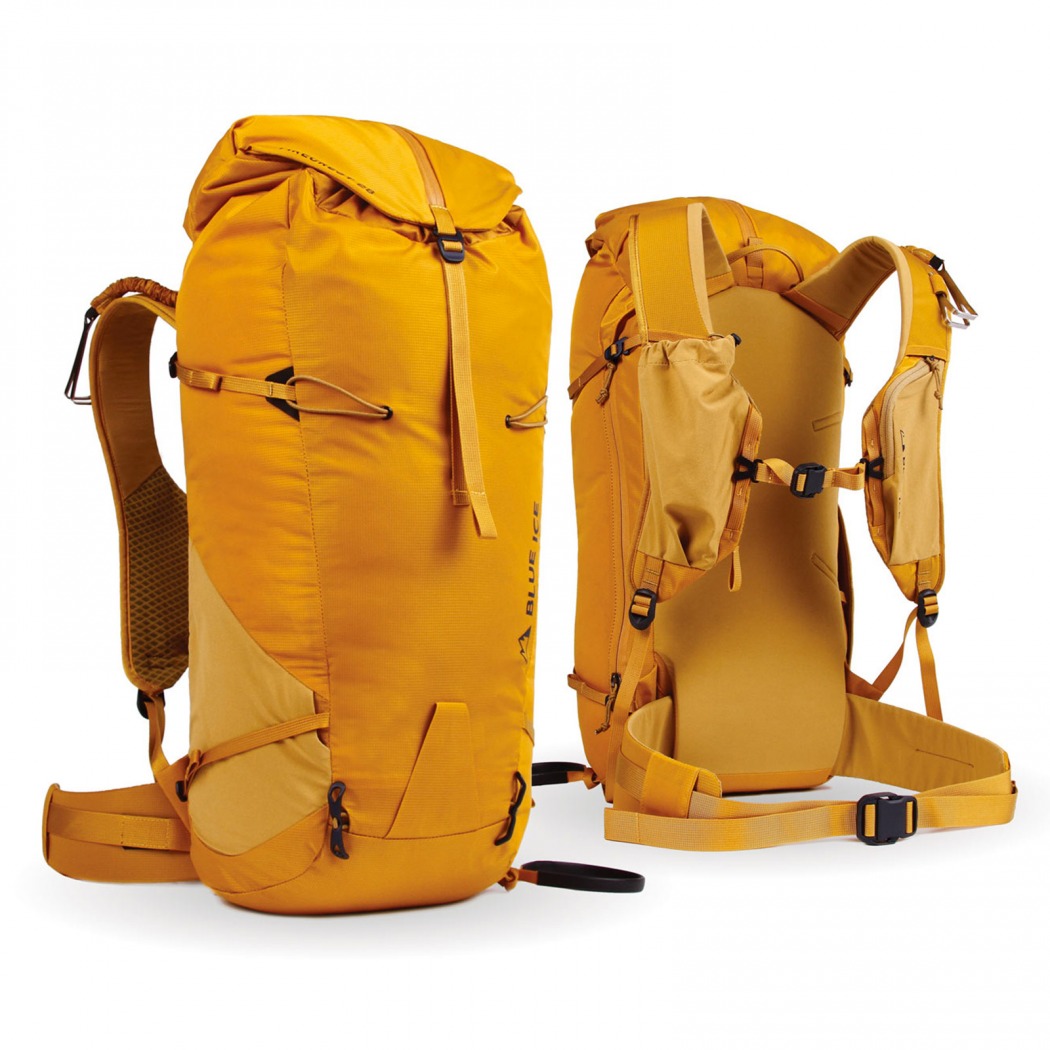
A clean front and back view of the Blue Ice Firecrest 28, a multi-purpose climbing/ski pack designed for the fleet footed. Features include quick access pockets on the shoulder straps, a full side zip, and a removable safety tool pocket/sleeve.
Blue Ice, a plucky technical gear company, has built a durable and multi-purpose ski and climbing pack in the Firecrest 28. For the fast-moving, the Firecrest 28 seamlessly incorporates the best attributes of mountain running vests into a functional and slick-looking ski pack.
For the past six months, I have had the privilege of testing the Blue Ice Firecrest 28L. I have put it through its paces on everything from traverses in the Tetons to mid-winter powder skiing in southwest Montana. For reference, I am 170 pounds, 6’0″ and tested the M/L size, which fit perfectly.
At first glance of the shoulder straps, it’s immediately obvious that the pack draws major inspiration from running packs. On smaller packs (<30L), I am a big fan of running vest style shoulder straps. In a pack of this size, you don’t need a ton of weight transferred to your hips, so it allows you to run the pack higher up, which frees up your hips for added mobility and keeps the pack off your harness if you’re wearing one.
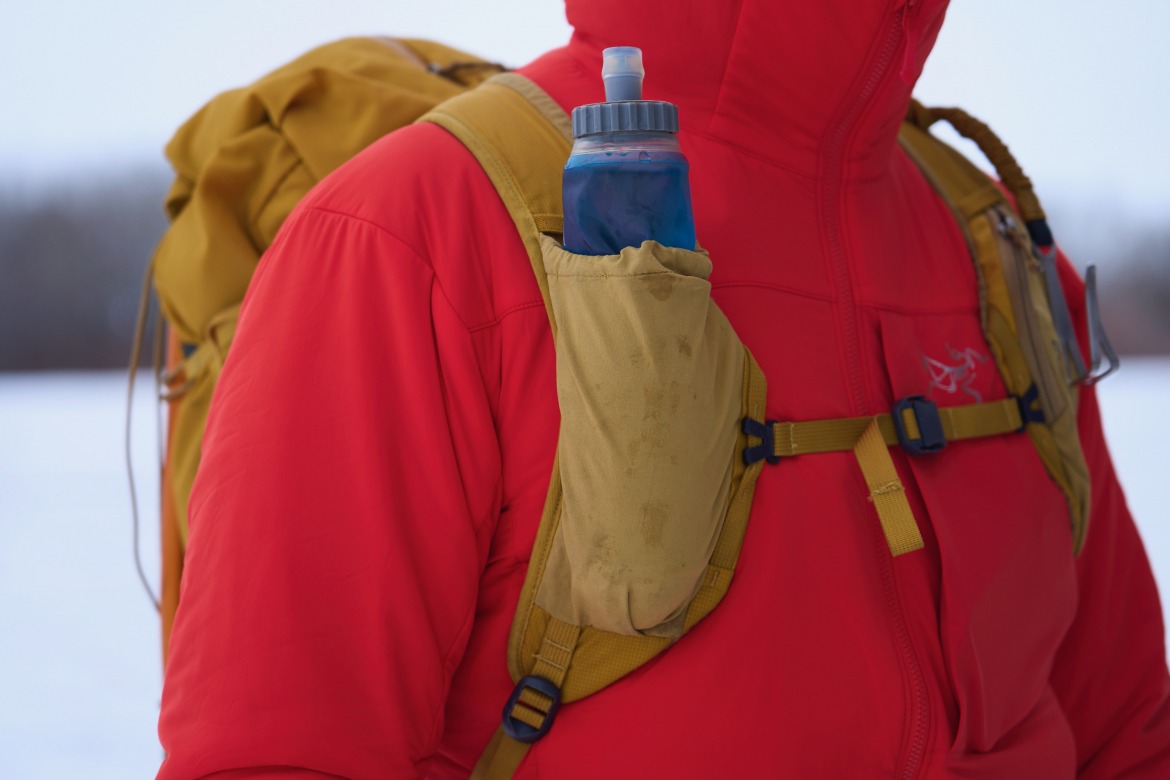
The Firecrest 28 uses the best function from running packs, on-the-go hydration access (left shoulder) and a zip-up pocket on the right shoulder strap.
The running vest style shoulder straps provide a multitude of benefits. Recall back to high school physics: pressure is force divided by area. More area is less pressure exerted on the chest and shoulders for a given load. Due to the integrated pockets in the shoulder straps (see below), the straps are wider than traditional shoulder straps—the physics work in your favor here.
The straps also allow for additional storage options. I can store my iPhone 13 Pro in the zippered pocket and hold a soft flask in the drawstring pocket. I like having quick access for hydration, and the flask pocket works great. It secures the flask with no perceptible movement when skinning, skiing, or climbing technical ground. Also, the dual vest-style pockets are a big advantage in the summer when wearing shorts without pockets and in the winter when wearing skimo tights without pockets. I wish the drawstring pocket were a bit longer to better accommodate 500 mL Salomon soft flasks and 0.6L Katadyn Befree Filters, which are my go-to soft flask options.
The Waist Belt
The design of the waist belt is nothing short of genius. Each side has a padded “wing” that you can store in the pack’s back panel without being detached. I found this especially nice in the summer when you have a rope and rack in the pack on the approach so you can transfer a little more of the load to your hips with the padded hip belt. Then when it’s time to climb, you can put away the “wings” and just use the webbing waist belt, which doesn’t interfere with your harness.
In the winter, I let the pack’s weight dictate whether additional padding is required. As noted, this is an easy adjustment as the minimalist hip pads stow away in the back panel.
More Firecrest 28 Details
This pack strikes a great balance between simplicity and ease of access. A side zipper to access the main compartment allows easy access to pull out a water bottle or jacket while on the go. It also features a stretchy external pocket on the left side, which you can access without taking the pack off. I hope you haven’t been neglecting your shoulder mobility workouts! The mesh pocket is perfect for storing gloves or snacks. I’ve used it to store micro spikes during the summer, and the mesh still looks good as new, which was a good test of its durability.

A Blue Ice provided image of the removable safety pocket. The pocket secures internally with a set of toggles.
The tool carry is simple yet effective for securing two ice axes or tools when your objectives require the sharps. There is no external crampon carry, so that tool must be stored inside the pack. The pack is extremely modular and lets you customize it based on what the day’s objective requires. The skimo carry items (i.e., the bungee clip and the tail loop) are easily removable yet functional for quick deployment for skinny of wider skis. The avalanche tool pocket is also easily removable. I found myself using the avalanche tool pocket sparingly; it takes up valuable volume in the pack, and fitting a shovel is a very tight fit with even the most compact metal shovels. I usually store my shovel and probe inside the main pack with the rest of the pack’s contents.
The specs for the pack mention that it is helmet carry compatible, but this requires purchasing a separate helmet holder from Blue Ice which was not tested. Generally, I am not a fan of external helmet carries as they are not the most secure and have caused me to lose a helmet on the skin track. If I don’t have room in the pack for my helmet, I start off wearing it. One less thing to fumble with on transitions as well.
The pack is lightweight but not a featherweight. Weight is often a tradeoff between usability and durability, and the Firecrest 28 strikes a good balance. The pack weighs 840 grams fully featured and 748 grams stripped down.
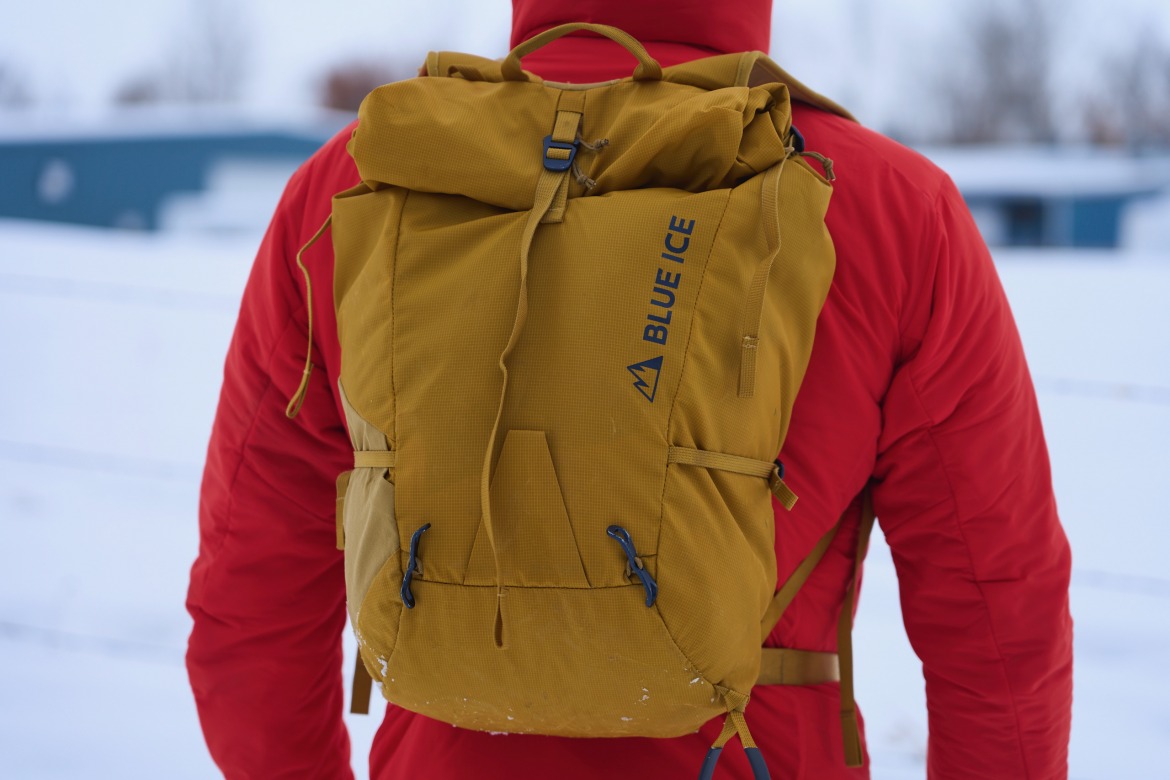
The top portion of the pack includes a zipped lid pocket with 2L of storage
and an under lid internal valuables pocket. If you do not have a full load, the pack easily compresses.
It’s glaringly obvious skiers, and climbers designed the pack. A prime example is the two different webbing slots for the strap that attach to the lid to the main body. There’s one on top of the lid and one on the bottom of the lid. When the pack is fully loaded, the webbing slot on the bottom of the lid works perfectly. When the pack is relatively empty, the webbing slot on the top of the lid helps cinch the pack down and keeps the lid from flopping around. The High Tenacity 210d Nylon also has the weight-durability metric dialed: the fabric has held up well to contact from ski edges.
For ski carry, the pack allows you to carry skis “skimo” style or A-frame. I tend only to use A-frame when carrying boots on the skis (for late spring and summer objectives) and prefer skimo style for most other occasions. Taking skis on and off without removing the pack saves valuable time on transitions. It’s especially handy when you’re only booting short sections that don’t quite require taking your pack off to rig an A-frame.
Not everyone will get away with a 28L pack for mid-winter ski touring, but if you can refine your kit, the Blue Ice Firecrest 28L is an extremely versatile pack. It excels at everything from uphilling at the resort, hunting powder in the backcountry, light and fast ski mountaineering, and alpine climbing in the summer.
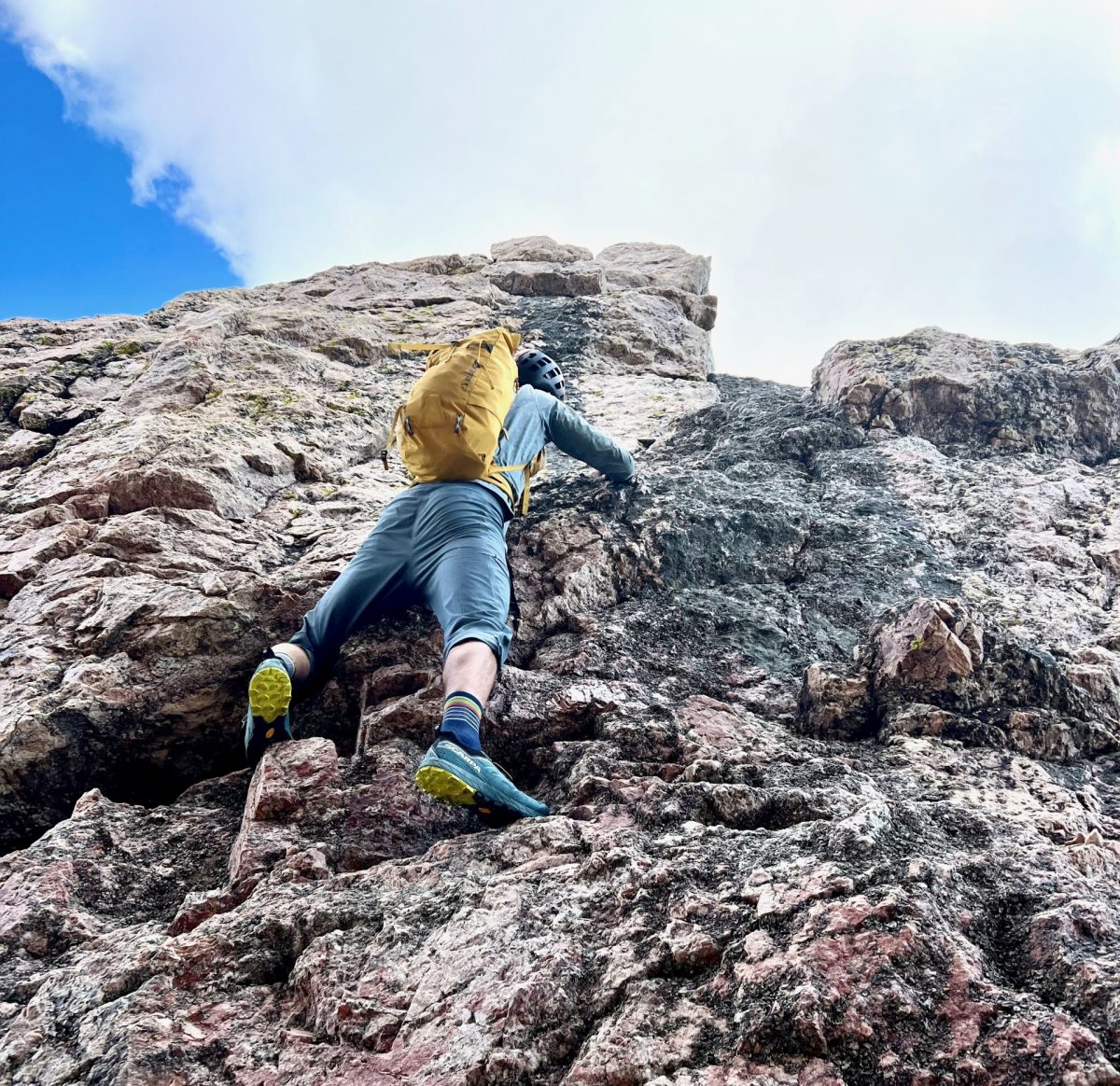
The Blue Ice Firecrest 28 is a ski pack that also excels in the summertime alpine. The removable safety pocket and ski carry system allows the pack to be a 12 month a year go-to. Photo: Austin Mallet
Blue Ice Firecrest 28 Features
Material: High Tenacity 210d Nylon 6.6
Shoulder Strap Quick Access: Hydration stash and zip pocket for nutrition/phone/what not.
Internal Storage: Zipped lid pocket with 2L of storage, under lid internal valuables pocket
Quick access to main compartment: Full length side access zip
Modular waistbelt:Stashable waist belt and Hip pad
Extra external pocket: Easy access stretch side pocket
Axe carry: Dual icetool carry
Ski carry: Quick skimo ski style carry system with stainless steel hook, and A-frame carry
Safety tool pocket: Sleeves for shove handle/probe/shovel blade — this is a removable avalanche tools pouch
Helmet carry: Helmet carry compatible, carry is sold separately
Sizes: Available in two back lengths (S/M & M/L)
Pack volume options: Also available in 38L
Claimed Weight: 840 g and 748 g without ski parts
Price: Firecrest 28 $159.95, Firecrest 38 $179.95
Shop for the Blue Ice Firecrest 28.
Shop for the Blue Ice Firecrest 38.
Austin Mallet is originally from the flatlands of Houston, TX. Once the career opportunity presented itself, he moved to Bozeman, MT and never looked back. It didn’t take long to fall in love with the mountains and all the activities they have to offer. While living in Texas, Austin raced road bikes so it was an easy transition into the spandex clad world of skimo racing. These days, Austin is most passionate about climbing (specifically in the alpine) and ski mountaineering with a little trail running mixed in for good measure.

